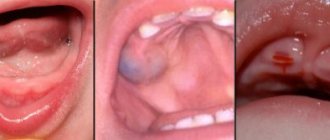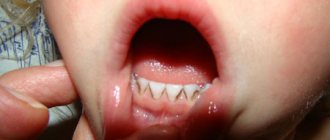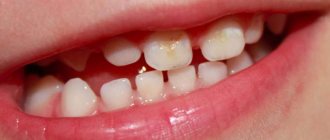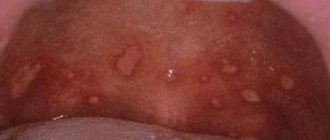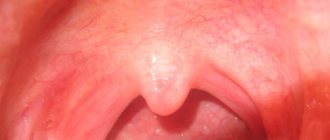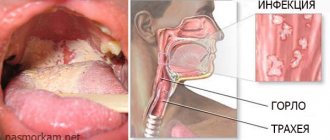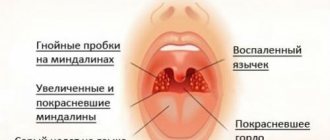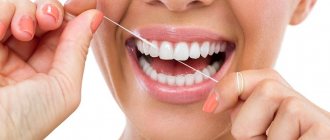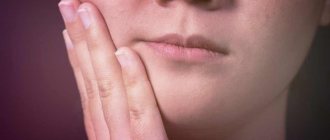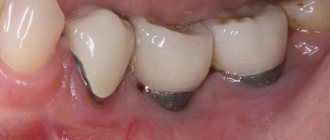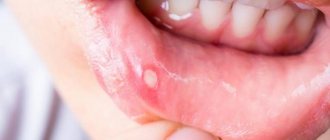White coating on the tongue, loss of appetite, increased moodiness - all these symptoms may indicate the presence of thrush in the child’s mouth. This is not an independent pathology, but a consequence of malfunctions of the immune, endocrine, and digestive systems, and non-compliance with hygiene standards by children and parents. To treat the oral cavity, medications and folk remedies are used.
Reasons for the appearance of a child
Candidal stomatitis
The main reasons for the development of fungal infections in children are non-compliance with dental care rules, the presence of carious teeth and other dental diseases, and decreased immunity.
Causes of candidal stomatitis:
- Taking antibiotics. Weakening of the immune system and active growth begins if antibacterial drugs are given to the child, or if a nursing mother takes potent medications - the active substances penetrate into breast milk.
- Violations of feeding techniques, pathologies of the nervous and digestive systems, which provoke frequent regurgitation in children. Leftover food is an excellent environment for the active growth of fungal spores.
- Improper care of nipples and bottles - yeast-like fungi often live on the surface of these objects.
- Frequent injury to the mucous membrane of the tongue, cheeks, and gums.
- The habit of constantly putting hands and toys into the mouth.
- Failure to comply with drinking regime, excessively dry air in the room. The amount of saliva, which has an antimicrobial effect, decreases.
- Frequent colds, weakened immunity due to chronic pathologies, radiation or chemotherapy sessions, and taking hormonal medications.
- Failure to comply with hygiene rules by parents.
- Vitamin deficiency - thrush often develops when the body receives insufficient vitamins B, PP, and ascorbic acid.
- Consuming large quantities of sweets, raw milk, poorly cooked meat, dirty vegetables and fruits.
- Dysbacteriosis, diabetes and other pathologies of the endocrine or digestive system.
- Allergic dermatitis, rickets, anemia.
Thrush is diagnosed in 20% of children under 1 year of age. This is due to the fact that the microflora in the mouth is constantly changing, the epithelium of the mucous membrane is not yet fully formed. All these factors contribute to the active growth and reproduction of yeast-like fungi.
Important! Oral candidiasis may be the first manifestation of blood cancer, a dangerous immunodeficiency condition.
Mechanism of occurrence
Fungi of the genus Candida are an opportunistic microorganism; 50-90% of people are carriers.
Under normal conditions, there are no symptoms of candidiasis; fungi begin to actively grow in the presence of certain factors. Then signs of infectious pathology appear.
Factors leading to the development of the disease
Various factors can provoke the active growth of fungi in the mouth of children.
Why thrush develops:
- Infants have poor nutrition from the mother. If a nursing woman’s diet is dominated by sweets, canned food and semi-finished products, and fast food, the risk of developing oral candidiasis in the baby increases several times.
- In young children - poor hygiene and teething, feeding with formulas high in sugar, and the habit of sleeping with a pacifier in the mouth.
- Older children have an unbalanced diet, improper tooth growth, caries and other dental diseases, wearing braces and plates to correct the bite.
- In adolescents, oral candidiasis often develops against the background of hormonal changes in the body, smoking, drinking alcohol or drugs, and hypothermia.
There is a high probability of developing oral candidiasis in premature babies and in bottle-fed children. Thrush is often diagnosed in newborns whose mothers have tuberculosis or HIV.
But the main provoking factors are considered to be improper oral care, decreased immunity, an acidic environment in the body, and constant exposure to a hot room with dry air.
Causes of thrush in a child’s mouth and methods of its treatment:
Routes of infection
Candida fungus
Thrush is an infectious disease that is transmitted from sick people to healthy people. Children most often become infected from their parents or from other children in kindergarten.
Main routes of infection:
- Intrauterine. Candida fungi penetrate the placenta, and the child is born with congenital candidiasis.
- During passage through the birth canal, if the woman has not treated genital candidiasis in time.
- Breasts can become infected during feeding if the fungus lives on the skin of the mammary glands.
- Contact. Infections are transmitted through handshakes, toys, and household items.
- The fungal infection is transmitted from young domestic animals and birds.
But even fungal infection does not always cause the development of an infectious process. It all depends on the state of the immune system and the presence of chronic diseases in the child.
Treatment of oral candidiasis in children
If you suspect thrush, your child should first be seen by a doctor. He will assess the extent of the fungus and prescribe adequate treatment.
The main principle of treating candidiasis is an integrated approach, which includes general and local therapy. This allows not only to relieve the symptoms of the disease, but also to eliminate the cause itself, which will significantly reduce the risk of relapse.
Treatment of candidiasis in children necessarily requires an individual approach in each specific case, since most often candidiasis develops against the background of changes in the composition of the natural microflora of the oral cavity and a decrease in the body's immune defense, caused by disruptions in the functioning of the body's protective factors.
The basic rule is that treatment must be carried out on time, and not to self-medicate - this is extremely dangerous, especially in the case of newborns and young children. Therefore, only a competent specialist can tell you how to treat candidiasis in children.
At the moment, systemic treatment with fluconazole-based drugs (Diflucan, Diflazon, etc.) is considered the most effective. Fluconazole is an antifungal agent that reduces the activity of fungi and stops their spread, i.e. has a powerful antifungal effect on the entire body at once. The drug is well tolerated and easy to use, since there are various ways of administering it (orally, intramuscularly, intravenously) depending on the severity of the condition. To select the necessary therapy, you must consult a doctor.
There are quite a few antifungal agents for topical use. External dosage forms (solution, gel, cream, ointment) act directly on the affected areas of the mucous membrane and quickly relieve the symptoms of a fungal infection. Children are often prescribed the drug Candide - this is an effective antifungal agent based on the substance clotrimazole, which destroys the fungus in the body and stops its spread. The drug Candide for children has become very widespread, as it is available in several dosage forms, which allows the use of the most convenient form depending on the nature of the disease and the age of the child. For example, if children need Candide for thrush in the mouth, then it is better to use a solution (drops), and for skin candidiasis in children it is recommended to use Candide in the form of a powder (powder) or cream. Before using the drug Candide, be sure to consult your doctor and read the instructions for use for children.
Also often, for oral candidiasis in children, treatment of the affected areas with dyes is prescribed - 1-2% solution of methylene blue (blue), brilliant green (brilliant green), antiseptics - 0.1-0.2% solution of chlorhexidine (rinsing, applications), which have a good antifungal effect.
Symptoms and external manifestations
Thrush can be recognized by examining the oral cavity; the child’s behavior also changes.
General signs:
- refusal to breastfeed or eat;
- weight loss;
- sleep disturbance;
- frequent regurgitation;
- complaints of pain, burning, itching in the mouth, sensation of a lump in the throat.
During infection, the condition of the mucous membrane changes, it becomes red and swollen, and areas of unnatural color appear.
Don't confuse plaque from breast milk with thrush!
Caring for a child with thrush
A sick baby needs additional care. Required:
- sterilize used bottles and nipples;
- limit the amount of time you suck on pacifiers;
- ventilate the room periodically.
When a baby develops thrush, he refuses to eat, largely due to painful sensations when sucking. So that the child does not remain hungry, you can give him an artificial mixture a little from a syringe or from a spoon. Expressed milk is also given.
Stages of development
The severity of thrush symptoms depends on the stage and severity of the disease.
| Stage | Characteristic manifestations |
| Lightweight | The oral mucosa is red and swollen, and rashes appear. A white coating forms on the tongue and cheeks in the form of small islands; at the initial stage, it is easily removed with a spoon. |
| Average | White plaques with a cheesy consistency cover the entire surface of the tongue. Bleeding ulcers and seizures appear. The child cries often and has poor appetite. |
| Heavy | A gray or pale yellow plaque covers not only the entire oral mucosa. But it also spreads to the lips, throat, and tonsils. The plaque is not removed; with strong pressure, bleeding ulcers appear. Additional symptoms are fever up to 38.5 degrees and above, weakness, drowsiness. The child stops eating and constantly complains of severe pain in the mouth. |
Diagnostics
You can recognize oral candidiasis on your own; the disease has a number of characteristic symptoms. But only a specialist can confirm or refute the diagnosis after an examination.
Independent
You can identify thrush yourself by examining the oral cavity.
A characteristic symptom is a white, yellowish, pale gray coating on the tongue and the inner surface of the cheeks. Plaque from oral candidiasis is difficult to remove; after removal, bleeding ulcers and red spots appear. Sometimes, during infection, the mucous membrane becomes smooth, shiny, with small white grains on the surface.
Precursors to the development of thrush in infants are worsening appetite and sleep, constant crying for no apparent reason, and irritability. Older children begin to complain of discomfort in the mouth while eating, although there may be no visible damage to the mucous membrane.
Important! One of the characteristic signs of thrush is the appearance of a sour odor from the mouth.
Professional
Diagnosis and treatment of oral candidiasis is carried out by a pediatrician or adolescent doctor, dentist, or ENT specialist.
After the examination, the doctor will prescribe the necessary tests and, based on the examination results, select safe medications. Diagnostic methods:
- clinical blood and urine analysis;
- bacteria culture of plaque;
- test to determine the sensitivity of the fungus to drugs;
- indirect laryngoscopy - allows you to see the severity of damage to the mucous membranes;
- tests to determine immune status;
- test to determine blood glucose levels.
Treatment
Treatment of candidiasis in the mouth is aimed at eliminating the manifestations of the disease and strengthening the immune system. The most commonly used are external antiseptics and antifungals. Tablets must be taken in severe cases of the disease. Alternative medicine methods will help enhance the effect of drug therapy.
Attention! When treating children, antifungal therapy must also be administered to the mother and all relatives who are in contact with the child.
Medication
The mainstay of treatment for oral candidiasis is antifungal drugs. Additionally, medications are prescribed to eliminate discomfort and strengthen protective functions :
- antifungal drugs - Candide, Nystatin.
- antiseptics - solution or ointment Miramistin, Chlorhexidine;
- antihistamines - Zyrtek, Tavegil, Telfast, eliminate itching and swelling of inflamed tissues;
- painkillers - Cholisal ointment, a local anesthetic, accelerates the healing process of ulcers and wounds;
- vitamin complexes, iron and calcium supplements.
Nystatin
Candide
Miramistin
Chlorhexidine
Zyrtec
Tavegil
Telfast
Holisal
Nystatin is one of the best remedies for treating fungal infections. The drug is produced in different forms and is prescribed for acute or severe disease. The duration of the course is 2 weeks.
Important! You should not interrupt the course of taking antifungal drugs, even if the signs of infection have completely disappeared. If the disease is not treated completely, the risk of relapse increases; pathogens will develop resistance to drugs.
Folk
Alternative medicine methods help eliminate plaque, signs of inflammation, and pain.
But they need to be used in combination with medications and diet; first, be sure to consult with your doctor. Recipes:
- Dissolve 5 g of baking soda in 250 ml of warm water. Soak a piece of gauze in the solution and treat the affected areas up to 5 times a day.
- Mix aloe juice and warm water in equal proportions. Soak a sterile cotton swab in the solution and treat ulcers and wounds.
- Mix equal parts of sage, eucalyptus, chamomile, and calendula. Pour 200 ml 1.5 tbsp. l. collection, leave in a sealed container for 20 minutes. Use the strained infusion for mouth treatment and rinsing. Carry out procedures 5-6 times a day.
- You can use fresh carrot juice to treat mucous membranes or rinse. Sessions are held every 2 hours. The method only helps with mild cases of the disease.
- To speed up the process of mucosal restoration after rinsing, lubricate the affected areas with sea buckthorn oil.
Although safe, natural remedies can cause severe allergic reactions. Carefully monitor the child’s condition; it is better not to use multicomponent formulations to treat children.
Diet
Diet therapy is one of the main components in the treatment of oral candidiasis. Yeast-like fungi love sweets, so sugar in any form should be excluded during treatment.
| Prohibited Products | Authorized Products |
|
|
To avoid increased pain and discomfort in the mouth, all food should be warm and have a soft consistency.
If a fungal infection is detected, a nursing mother also needs to review her diet. You can eat vegetables, unsweetened fruits, dietary meat and fish, buckwheat, oatmeal, eggs. Completely give up coffee and black tea, sweets and baked goods, milk, mushrooms.
Advice! In order for the body to quickly cleanse itself of toxic fungal waste, it is necessary to consume more fluid. This can be purified water without gas, chamomile and mint tea, or a decoction of rose hips.
Pharmaceutical preparations for external use
It is sometimes quite difficult to cure thrush in children without the use of special medications. For mild to moderate severity of candidiasis, medications intended for external application to the affected mucous membranes are used, these are:
- Candide solution
. A few drops of the drug should be placed on a cotton swab and used to treat the oral cavity. Use the medicine three times a day before feeding. At the same time, the mother should lubricate the nipples with the solution. - Miramistin
. When treating newborn children, it is better to use a solution; the mucous membrane of the mouth of a one-year-old child can already be irrigated with a spray. Miramistinam treatment is carried out after preliminary removal of plaque using a soda solution. - Nystatin
. A tablet of the drug in 250 thousand units. should be diluted in a glass of water. A cotton swab is moistened in the resulting solution, after which the mucous membranes in the mouth are treated. If ulcers appear, you can use nystatin ointment. - Potassium permanganate
. Make a 5% solution of potassium permanganate, the color turns out purple. Lubricate the internal surfaces of the oral cavity with potassium permanganate up to 5 times a day. Just be sure to carefully dilute the permanganate, since the remaining grains can cause a burn to the mucous membrane.
When using pharmaceutical antifungal agents, you must take into account all contraindications to their use.
Features of treatment of children, depending on age
When choosing medications, be sure to consider the child’s age and weight and the severity of oral candidiasis.
How to treat oral candidiasis in children:
| Age | Effective and safe drugs |
| Newborns | Candida solution. |
| From 6 months to a year | Treat problem areas with Fucis DT solution. Dosage – 3 mg/kg. Dilute the required amount with water. In severe cases of the disease - Diflucan and Fluconazole tablets. |
| Since the year | For treating inflamed areas - Miramistin, Lugol, nystatin ointment, Triderm ointment (from 2 years), Pimafucort (from 1 year). For rinsing - a solution of saline solution and Nystatin tablets. Antihistamines for severe itching - Erius, Fenistil. Additionally - B vitamins, calcium gluconate, Ferrum-Lek. |
| 5 years and older | Vfend is an effective antifungal agent, but can be used to treat children over 5 years of age. Sprays and solutions with antiseptic action - Stomatidin, Stopangin. If complications are detected, use Nystatin. The dosage is calculated by the doctor. |
How to properly treat your baby's mouth
Children under 3-4 years old cannot rinse their mouths, so if they have oral candidiasis, parents need to constantly rinse their mouths with it.
Step-by-step instruction:
- Wash your hands thoroughly and treat with antiseptic.
- Wrap a small piece of gauze, always sterile, around your index finger.
- Dip your finger and gauze in warm water.
- Gently, without pressure, remove plaque from the tongue and cheeks.
- Throw away the gauze and wrap a new piece. Dip your finger into a solution of soda or Miramistin and treat the problem areas again.
You need to remove plaque up to 7 times a day, always after every meal, before bed, and in the morning immediately after waking up.
Quick treatment for thrush:
Treatment of thrush after taking antibiotics
Long-term or improper treatment with antibacterial drugs is one of the common causes of the development of childhood oral candidiasis.
Potent medications destroy all bacteria, harmful and beneficial, which provokes an imbalance of microflora in the body. Many parents believe that modern broad-spectrum antibiotics cannot cause dysbiosis. This is not true; there are no absolutely safe antimicrobial drugs. All of them negatively affect the balance of microflora to a greater or lesser extent.
Treatment of thrush after taking antibiotics is no different from treatment of other forms of the disease. Local antifungal and painkillers, antiseptics, antihistamines, and vitamins are prescribed.
But in addition, you definitely need to take medications to restore the microflora :
- Linux . Capsules contain live bacteria. Can be taken by children of any age.
- Bifidumbacterin . The drug contains live bifidobacteria and is produced in different forms, which allows you to choose a medicine for a child at any age.
- Trilact . Probiotic in emulsion form. It is allowed to give to children over 18 months.
Linex
Bifidumbacterin
Trilact
Reference! Useful lactobacilli for the intestines are also contained in some products - biokefir, hard cheese Slavyansky, Olympus, Imunele yogurt, Actimel.
Prevention
To prevent thrush (in a one-month-old baby and older), it is necessary to ensure long-term breastfeeding. Since thrush is transmitted through objects, air, and saliva, parents must carefully follow hygiene rules:
- do not kiss the child on the face;
- thoroughly wash toys and objects that are near the child;
- wash nipples and bottles with baking soda and boiling water;
- for a nursing mother, observe the rules of personal hygiene, treat nipples with 2% soda solution or borax;
- wash your hands thoroughly before picking up your baby;
- Mothers should avoid taking antibiotics while breastfeeding.
In what cases can you cope with thrush in a child on your own?
Mild forms of thrush can be treated independently at home, but only after visiting a specialist.
The key to successful treatment is regular examinations with a doctor, following all his recommendations, following a diet, maintaining cleanliness and optimal climatic conditions in the room.
When medical attention is required
It is imperative to consult a doctor and undergo a full examination if symptoms of thrush are detected in a child older than one year.
Provided that he did not take antibiotics in the next month. In what cases is inpatient treatment required:
- mouth ulcers bleed heavily;
- body temperature rises;
- signs of an imbalance in the intestinal microflora appear;
- candidiasis spreads to the perineal area;
- the child does not eat or drink anything at all due to severe pain.
Relapses of oral candidiasis are often diagnosed. Therefore, after recovery, it is necessary to show the child to the doctor once every 3 months and take tests again.
How to spot thrush in time
It is extremely difficult to recognize oral thrush in children by the first symptoms: redness and swelling that can appear on the roof of the mouth, tonsils, gums, tongue and the inside of the cheeks. Next, on the red shiny background of the mucous membrane, which is already beginning to hurt and itch, white grains appear, similar to semolina. They can be easily removed with a spoon.
The next stage will be an increase in plaque, which is already becoming similar to the remains of cottage cheese in the mouth (less often, it has a grayish or yellowish tint). If you remove them with a blunt object (spoon, spatula), a red shiny surface will be visible underneath them, on which, if you scrape hard, droplets of blood appear, resembling dew. Changes in the mucous membrane are accompanied by pain and burning in the mouth. They get worse when swallowing and eating food, especially if it is spicy, hot or sour. There is also a metallic taste in the mouth. Because of this, the child cries and refuses to eat. In the absence of treatment at this stage, or if the child’s immunity is severely suppressed, the white films spread further and further, the body temperature rises, sleep is disturbed, the infant may spit up frequently and stop gaining weight.
The feeling of a “lump in the throat,” which only older children can complain about, is a sign that the thrush has spread to the throat.
Sometimes thrush in children looks like a jam - a crack in the corner of the mouth. It differs from cracks formed due to vitamin A deficiency in that there is redness around the crack, and it itself is covered with a whitish coating. Candidiasis is rarely accompanied by fever or deterioration of the general condition, but it makes opening the mouth painful. This form of thrush occurs more often in children who suck a pacifier or thumb.
Thus, parents of infants should be wary and examine the child's mouth if he:
- cries when he puts a pacifier or breast in his mouth;
- refuses breastfeeding;
- capricious, he has an elevated temperature without snot and cough.
What parents shouldn't do
When identifying signs of thrush in a child, parents do not need to panic. Most children tolerate the disease well, all unpleasant symptoms disappear within 5-7 days.
You cannot self-medicate ; you need to consult a doctor. Before visiting a doctor, you can treat problem areas only with a soda solution; at temperatures above 38 degrees, you can give an antipyretic, and for severe itching, an antihistamine. The remaining medications will be prescribed by a specialist.
It is strictly forbidden to scrape off plaque. When the mucous membrane is injured, microbes can penetrate into the wounds, which is fraught with the development of purulent processes and complications. When refusing food, you should not force the child to eat, but you should constantly offer food and water. As soon as the discomfort subsides a little, your appetite will appear.
Important! In the treatment of oral candidiasis in children, honey and alcohol solutions should not be used. All these methods only make the problem worse.
Thrush in newborns' mouth
Pediatricians say that oral candidiasis in newborns does not require drug therapy.
This category of patients is prescribed only drugs that can alleviate the condition and eliminate unpleasant symptoms.
Forecast
The prognosis for candidal stomatitis is favorable; with timely diagnosis and proper treatment, complications rarely occur.
Severe consequences of the disease can occur in children with weakened immunity, chronic diseases of the endocrine and digestive systems. In the absence of adequate therapy, the disease becomes chronic, which is fraught with frequent relapses even with the slightest hypothermia.
Possible complications
Most often, Candida fungi affect only the superficial layers of the mucous membrane. But without proper and timely treatment, pathogens penetrate other organs and severe complications develop.
Consequences of oral thrush:
- inflammation of the cervical lymph nodes;
- disruptions in the functioning of the heart, kidneys, liver, and digestive system;
- meningitis, sepsis, severe forms of tonsillitis;
- infectious pathologies of the respiratory tract;
- severe exhaustion and dehydration.
Long-term or chronic oral candidiasis leads to severe weakening of the immune system. The child begins to get sick often, even a simple cold often leads to the development of complications.
In girls and boys, thrush in the mouth can cause the development of vaginal candidiasis. The disease negatively affects the functioning of the genitourinary system and the development of the genital organs. For treatment, ointments and suppositories with antifungal action are prescribed.
Preventive measures
Don't forget to thoroughly clean pacifiers, bottles and other devices!
Thrush in the mouth often occurs in children, especially between the ages of 1 and 5 years. The pathology is highly treatable if detected early. But in order to protect your child from taking medications and unpleasant procedures, you need to constantly engage in disease prevention.
How to prevent the development of a fungal infection:
- do not allow the child to put fingers or any objects into his mouth, especially while walking on the street;
- You cannot kiss a child on the lips and prohibit other relatives from doing this;
- carry out wet cleaning daily, wipe off dust, treat toys, ventilate and moisten the room;
- thoroughly boil pacifiers, bottles, teethers;
- teach your child to wash their hands after going outside and going to the toilet, before eating, and to properly care for their teeth;
- take your child to the dentist twice a year, even if nothing bothers you;
- The diet should contain fresh fruits and vegetables - they have a beneficial effect on the immune system;
- the child should know that it is forbidden to use other people’s towels and toothbrushes;
- to avoid intrauterine infection, a woman needs to cure vaginal candidiasis before conception, and during pregnancy try to avoid factors that can provoke the development of a fungal infection;
- A nursing mother needs to properly care for her breasts, rinse the mammary glands with warm water before feeding, and treat the nipples with a soda solution after feeding.
A strong immune system protects not only from thrush, but also other diseases. To strengthen protective functions, the child must move more, be sure to walk in the fresh air, and follow a daily routine.
Prevention of thrush
During pregnancy, a woman should closely monitor her health and try to avoid infectious diseases, because it can be difficult to remove and cure thrush in a newborn with a weakened immune system. To prevent the possibility of re-infection, you should:
- Take good care of breast hygiene if a small child is breastfed. Clean bottles well before and after feeding;
- wash toys, as well as all objects that a child can put in his mouth;
- after feeding, rinse the baby’s mouth with clean boiled water, giving it with a spoon or from a bottle;
- Don’t forget to strengthen children’s immunity, spend more time in the fresh air.
Remember: it is always better to prevent a disease than to try to cure it! Careful care and attention to the baby will help him endure thrush easily and painlessly, or even avoid this scourge altogether.
I like 0
Thrush Candidiasis Child Children Disease Disease Fungus Treatment Folk Remedies
Related Posts
leave a comment
Only 3 comments.
Evgeniya
with us 5 years, 8 months, 10 days
2017-11-13 09:03:42Treatment with soda is the least libidinous thing, but even then this is just a symptomatic treatment. What kind of dinosaur do you have to be to suggest treating a child with antifungal drugs, when it is necessary not to remove the symptoms, but to eliminate the root cause??? The root cause is correct, the weakness of the immune system, which depends on the balance of the intestinal microflora, and it must be restored with the help of lactobacterin. It is lacto - and not bifidobacterin, and even in the pharmacy you meet “smart” women with the words - “take it, it’s the same thing”…. One ampoule of Lactobacterin per day - 15-20 minutes before feeding, dissolved with warm water - and by 3-1 days the baby will not have a trace of white plaque left!!! And yes - if the baby (or mother!) is constipated, this is also a sign of a lack of lactobacterin!!! Baby - 5 days, mom - 5-7 days of lactobacterin course per month - and everything is fine. Lactobacilli play a huge role in our lives, but modern medicine still offers everything the old fashioned way,,, (((
Evgeniya
with us 5 years, 8 months, 10 days
2017-11-13 08:56:59Lactobacterin - and only lactobacterin! Not when nothing helped - but INSTEAD of all this ancient medicine!!!
